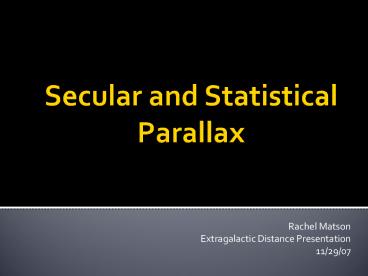Secular and Statistical Parallax - PowerPoint PPT Presentation
1 / 17
Title:
Secular and Statistical Parallax
Description:
Rachel Matson. Extragalactic Distance Presentation. 11/29/07. Limited by size ... If the speed of the individual star was known to be v, then it is better by a ... – PowerPoint PPT presentation
Number of Views:571
Avg rating:3.0/5.0
Title: Secular and Statistical Parallax
1
Secular and Statistical Parallax
- Rachel Matson
- Extragalactic Distance Presentation
- 11/29/07
2
Trigonometric Parallax
- Limited by size of angle
- Extend range with larger baseline
3
Space Velocity
- Stars velocity with respect to the LSR
- U - radially outward from the galactic center
- V -in the direction of galactic rotation
- W -in the direction of the galactic north pole
4
Secular Parallax
- v? 20 km/s ? Sun moves 4 AU/yr disk
- v? 200 km/s ? Sun moves 40 AU/yr halo
- After a time t of several decades, accumulated
baseline vt is several orders of magnitude larger
than the Earth-Sun baseline.
5
Secular Parallax
- If the speed of the individual star was known to
be v, then it is better by a factor of vt/AU over
trigonometric parallax (same astrometric
accuracy). - The drawback is that the stars have a dispersion
s, so the precision of the distance determination
is inversely proportional to the Mach number, ?
v/s (Popowski 1998). - Apply method to a sample of N stars, drive down
noise and achieve a precision aN-1/2 ?-1
6
Secular Parallax
- Use point of convergence to find space velocity
- Deduce distance by comparing actual speed with
its apparent speed
7
Secular Parallax
- Green stars-small mean distance
- Red stars -large mean distance
- Average proper motion of stars away from the
point of the sky the Solar System is moving
towards (apex) - ? angle to apex
- d?/dt proper motion
- ? proportional to sin ?
- µ slope of line
- Mean distance
- Dcm V? cm/sec / µ radians/sec
- Dpc 4.16 / (µ "/yr )
8
Secular Parallax
9
Hipparcos and Secular Parallax
- Hipparcos proper motions (larger relative
precision than trig. parallax) to derive 3
times more precise distance estimates (de Bruijne
et al. 2000) - Secular parallax
- A 4.740 km yr s-1
- µ proper motion vectors
- v common space motion
- ? angular dist between a
- star and cluster apex
Vx -5.84km/s Vy 45.68km/s Vz 5.54km/s s
0.30 km/s
10
Hipparcos and Secular Parallax
- Color-absolute magnitude diagrams of Hyades
Hipparcos trigonometric parallaxes (L), Hipparcos
secular, and Tycho-2 secular parallaxes (R)
11
Statistical Parallax
- When the stars have measured radial velocities,
then the scatter in their proper motions can be
used to determine the mean distance. - Assume velocities isptropically distributed
12
Statistical Parallax
- Observed radial velocity
- Since v? is xiµi
- Statistical parallax
13
Secular and Statistical Parallax
- Secular parallax is based on forcing equality
between the three first moments of the velocity
distribution - from radial velocity and proper-motion
measurements - Classical statistical parallax is based on
forcing equality of the six second moments - six independent components of the velocity
covariance - Modern statistical parallax determines ten
parameters simultaneously by applying maximum
likelihood
14
Statistical Parallax
- Ideally, the statistical parallax method should
be applied to a group of stars that are - (1) dynamically homogeneous, i.e., all the stars
are drawn from a single velocity distribution
(not constrained to be Gaussian), regardless of
their locations - (2) standard candles, i.e., all have the same
absolute magnitude.
15
RR Lyrae and Statistical Parallax
- One of the main luminosity calibration methods
for RR Lyrae stars - All systematic errors in the statistical parallax
measurement of the absolute magnitude of RR Lyrae
stars will have been removed or quantified, and
the statistical errors will become the true
uncertainty (Popowski and Gould 1999).
16
LMC Distance Comparison
- Recent distant moduli to the LMC from statistical
parallax of RR Lyrae stars (L) and trigonometric
parallax of cepheids (R)
17
Conclusions
- Secular and statistical parallax
- Statistical depends on stars random velocities
- Secular exploits solar motion
- Clusters of stars
- Range d500 pc































